10.4: Visual Language Processing
- Last updated
- Save as PDF
- Page ID
- 92062

- Wikipedia
The processing of written language is performed when we are reading or writing and is thought to happen in a distinct neural processing unit than auditory language processing. Reading and writing respectively rely on vision whereas spoken language is first mediated by the auditory system. Language systems responsible for written language processing have to interact with a sensory system different from the one involved in spoken language processing.
Visual language processing in general begins when the visual forms of letters (“c” or “C” or “c”) are mapped onto abstract letter identities. These are then mapped onto a word form and the corresponding semantic representation (the “meaning” of the word, i.e. the concept behind it). Observations of patients that lost a language ability due to a brain damage led to different disease patterns that indicated a difference between perception (reading) and production (writing) of visual language just like it is found in non-visual language processing.
Alexic patients possess the ability to write while not being able to read whereas patients with agraphia are able to read but cannot write. Though alexia and agraphia often occur together as a result of damage to the angular gyrus, there were patients found having alexia without agraphia (e.g. Greenblatt 1973, as cited in M. T. Banich, “Neuropsychology“, p. 296) or having agraphia without alexia (e.g. Hécaen & Kremin, 1976, as cited in M. T. Banich, “Neuropsychology“, p. 296). This is a double dissociation that suggests separate neural control systems for reading and writing.
Since double dissociations are also found in phonological and surface dyslexia, experimental results support the theory that language production and perception respectively are subdivided into separate neural circuits. The two route model shows how these two neural circuits are believed to provide pathways from written words to thoughts and from thoughts to written words.
Two routes model
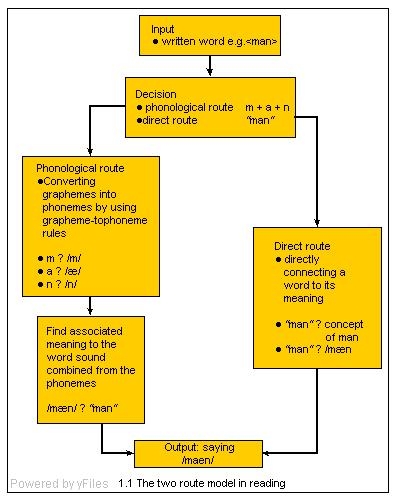
1.1. Each route derives the meaning of a word or the word of a meaning in a different way
In essence, the two routes model contains two routes. Each of them derives the meaning of a word or the word of a meaning in a different way, depending on how familiar we are with the word.
Using the phonological route means having an intermediate step between perceiving and comprehending of written language. This intermediate step takes places when we are making use of grapheme-to-phoneme rules. Grapheme-to-phoneme rules are a way of determining the phonological representation for a given grapheme. A grapheme is the smallest written unit of a word (e.g. “sh” in “shore”) that represents a phoneme. A phoneme on the other hand is the smallest phonological unit of a word distinguishing it from another word that otherwise sounds the same (e.g. “bat” and “cat”). People learning to read or are encountering new words often use the phonological route to arrive at a meaning representation. They construct phonemes for each grapheme and then combine the individual phonemes to a sound pattern that is associated with a certain meaning (see 1.1).
The direct route is supposed to work without an intermediate phonological representation, so that print is directly associated with word-meaning. A situation in which the direct route has to be taken is when reading an irregular word like “colonel”. Application of grapheme-to-phoneme rules would lead to an incorrect phonological representation.
According to Taft (1982, as referred to in M. T. Banich,“Neuropsychology“, p. 297) and others the direct route is supposed to be faster than the phonological route since it does not make use of a “phonological detour” and is therefore said to be used for known words ( see 1.1). However, this is just one point of view and others, like Chastain (1987, as referred to in M. T. Banich, “Neuropsychology“, p. 297), postulate a reliance on the phonological route even in skilled readers.
The processing of written language in reading
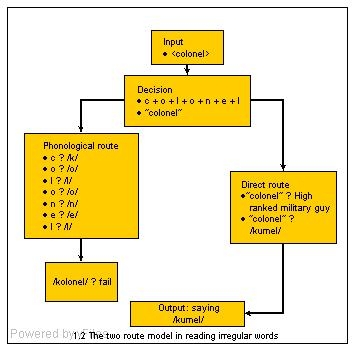
1.2. Regularity effects are common in cases of surface alexia
Several kinds of alexia could be differentiated, often depending on whether the phonological or the direct route was impaired. Patients with brain lesions participated in experiments where they had to read out words and non-words as well as irregular words. Reading of non-words for example requires access to the phonological route since there cannot be a “stored” meaning or a sound representation for this combination of letters.
Patients with a lesion in temporal structures of the left hemisphere (the exact location varies) suffer from so called surface alexia. They show the following characteristic symptoms that suggest a strong reliance on the phonological route: Very common are regularity effects, that is a mispronunciation of words in which the spelling is irregular like "colonel" or "yacht" (see 1.2). These words are pronounced according to grapheme-to-phoneme rules, although high-frequency irregularly spelled words may be preserved in some cases, the pronunciation according to the phonological route is just wrong.
Furthermore, the would-be pronunciation of a word is reflected in reading-comprehension errors. When asked to describe the meaning of the word “bear”, people suffering from surface alexia would answer something like “a beverage” because the resulting sound pattern of “bear” was the same for these people as that for “beer”. This characteristic goes along with a tendency to confuse homophones (words that sound the same but are spelled differently and have different meanings associated). However, these people are still able to read non-words with a regular spelling since they can apply grapheme-to-phoneme rules to them.
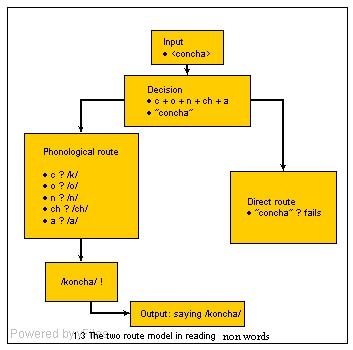
1.3. Patients with phonological alexia have to rely on the direct route
In contrast, phonological alexia is characterised by a disruption in the phonological route due to lesions in more posterior temporal structures of the left hemisphere. Patients can read familiar regular and irregular words by making use of stored information about the meaning associated with that particular visual form (so there is no regularity effect like in surface alexia). However, they are unable to process unknown words or non-words, since they have to rely on the direct route (see 1.3).
Word class effects and morphological errors are common, too. Nouns, for example, are read better than function words and sometimes even better than verbs. Affixes which do not change the grammatical class or meaning of a word (inflectional affixes) are often substituted (e.g. “farmer” instead of “farming”). Furthermore, concrete words are read with a lower error rate than abstract ones like “freedom” (concreteness effect).
Deep Alexia shares many symptomatic features with phonological alexia such as an inability to read out non-words. Just as in phonological alexia, patients make mistakes on word inflections as well as function words and show visually based errors on abstract words (“desire” → “desert”). In addition to that, people with deep alexia misread words as different words with a strongly related meaning (“woods” instead of “forest”), a phenomenon referred to as semantic paralexia. Coltheart (as referred to in the “Handbook of Neurolinguistics”, ch.41-3, p. 563) postulates that reading in deep dyslexia is mediated by the right hemisphere. He suggests that when large lesions affecting language abilities other than reading prevent access to the left hemisphere, the right-hemispheric language store is used. Lexical entries stored there are accessed and used as input to left-hemisphere output systems.
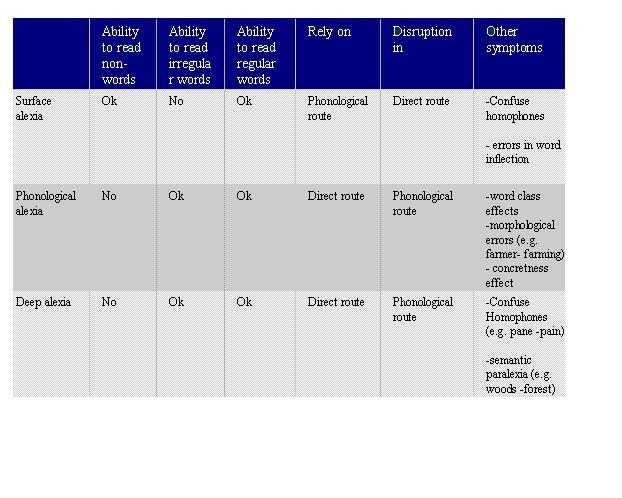
Overview alexia
The processing of written language in spelling
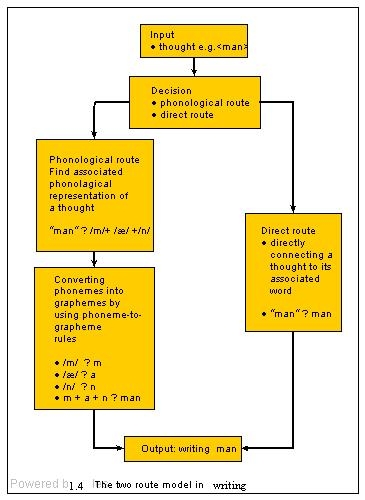
The phonological route is supposed to make use of phoneme-to-grapheme rules while the direct route links thought to writing without an intermediary phonetic representation
Just like in reading, two separate routes –a phonological and a direct route- are thought to exist. The phonological route is supposed to make use of phoneme-to-grapheme rules while the direct route links thought to writing without an intermediary phonetic representation (see 1.4).
It should be noted here that there is a difference between phoneme-to-grapheme rules (used for spelling) and grapheme-to-phoneme rules in that one is not simply the reverse of the other. In case of the grapheme “k” the most common phoneme for it is /k/. The most common grapheme for the phoneme /k/, however, is “c”. Phonological agraphia is caused by a lesion in the left supramarginal gyrus, which is located in the parietal lobe above the posterior section of the Sylvian fissure (M. T. Banich, “Neuropsychology“, p. 299). The ability to write regular and irregular words is preserved while the ability to write non-words is not. This, together with a poor retrieval of affixes (which are not stored lexically), indicates an inability to associate spoken words with their orthographic form via phoneme-to-grapheme rules. Patients rely on the direct route, which means that they use orthographic word-form representations that are stored in lexical memory. Lesions at the conjunction of the posterior parietal lobe and the parieto-occipital junction cause so called lexical agraphia that is sometimes also referred to as surface agraphia. As the name already indicates, it parallels surface alexia in that patients have difficulty to access lexical-orthographic representations of words. Lexical agraphia is characterised by a poor spelling of irregular words but good spelling for regular and non-words. When asked to spell irregular words, patients often commit regularization errors, so that the word is spelled phonologically correct (for example, “whisk” would be written as “wisque”). The BEST to CONNECT is to CAPITALISE the WORDS you WANT TO COMMUNICATE for readers to COMPREHEND.

Overview agraphia
Evidence from Advanced Neuroscience Methods
How can we find evidence for the theory of the two routes. Until now neuroscientific research is not able to ascertain that there are neural circuits representing a system like the one described above. The problem of finding evidence for visual language processing on two routes in contrast to one route ( as stated by e.g. from Seidenberg & McClelland as referred to in M. T. Banich,“Neuropsychology“, p. 308) is that it is not clear what characteristic brain activation would indicate that it is either happening on two or one routes. To investigate whether there are one or two systems, neuroimaging studies examine correlations between the activations of the angular gyrus, which is thought to be a crucial brain area in written language processing and other brain regions. It was found out that during reading of non- words ( which would strongly engage the phonological route) the activation is mostly correlated with brain regions which are involved in phonological processing e.g. superior temporal regions (BA 22) and Boca’s area. During reading of normal words (which would strongly engage the direct route) the highest activation was found in occipital and ventral cortex. That at least can imply that there are two distinct routes. However, these are conclusions drawn from highest correlations which do not ensure this suggestion. What neuroimaging studies do ascertain is that the usage of a phonological and a direct route strongly overlap, which is rather unspectacular since it is quiet reasonable that fluent speaker mix both of the routes. Other studies additionally provide data in which the activated brain regions during reading of non-words and reading of normal words differ. ERP studies suggest that the left hemisphere possesses some sort mechanism which response to combinations of letters in a string, or to its orthography and / or to the phonological representation of the string. ERP waves differ, during early analysis of the visual form of the string, if the string represents a correct word or just pronounceable nonsense (Posner & McCandliss, 1993 as referred in M.T. Banich, „Neuropsychology“p. 307-308). That indicates that this mechanism is sensitive to correct or incorrect words.
The opposite hemisphere, the right hemisphere, is in contrast to the left hemisphere, not involved in abstract mapping of word meaning but is rather responsible for encoding word specific visual forms. ERP and PET studies provides evidence that the right hemisphere responds in a stronger manner than the left hemisphere to letter like strings. Moreover divided visual field studies reveal that the right hemisphere can better distinguish between different shapes of the same letter (e.g. in different handwritings) than the left hemisphere. The contribution of visual language processing on both hemispheres is that the right hemisphere first recognizes a written word as letter sequences, no matter how exactly they look like, then the language network in the left hemisphere builds up an abstract representation of the word, which is the comprehension of the word.

